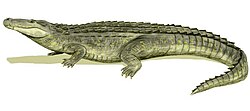| Procaimanoidea Temporal range: Eocene, | |
|---|---|
 | |
| Fossil specimen of P. utahensis | |
| Scientific classification | |
| Kingdom: | Animalia |
| Phylum: | Chordata |
| Class: | Reptilia |
| Clade: | Archosauria |
| Order: | Crocodilia |
| Superfamily: | Alligatoroidea |
| Family: | Alligatoridae |
| Subfamily: | Alligatorinae |
| Genus: | † Procaimanoidea Gilmore, 1946 |
| Species | |
| |
Procaimanoidea ("Before Caiman-forms") is an extinct genus of alligatorid from the Eocene of North America. It was named posthumously in 1946 by Charles W. Gilmore; the type species is P. utahensis, from the Uintan (middle Eocene) of Utah. It is based on USNM 15996, a nearly complete skull and partial left hind leg. [2] A second species, P. kayi, was named in 1941 by C.C. Mook as a species of Hassiacosuchus , for remains from the Bridgerian (early Eocene) of Wyoming. [3] It was reassigned to Procaimanoidea in 1967 by Wassersug and Hecht. [4]


